When you’re growing a grapevine, then you get to find out firsthand just how many creatures in Nature share our love for grapes. It can be a little trying, but with companion planting you can use Nature’s own little tricks to help give your grapevine a fighting chance to thrive.
If you’re a little new to companion planting, then don’t worry – we’ve got you covered! In this article, we’re going to share with you some of the best companion plants for grapes so that you can plan what perks you’d like them to have and we’ll also help you avoid trouble by warning you about pairings that will DEFINITELY not work well.
By the time we’re done, you’ll have a good starting point for a little companion planting on your own and once you see what it can do for your grapes, then you’re going to have a whole lot of fun with it. If you’re ready, then let’s talk about companion plants for grapes and making the most of Nature’s gifts to your garden!
Table of Contents
Good companion plants for Grapes
In the sections below we’ve compiled a list of potential ‘roomies’ for your grapevine that all bring a little something extra to the table. To keep things fresh and fun, we’ve compiled some medicinal and kitchen herbs, healthy veggies and delicious fruits, and some ornamentals so that your garden won’t be stuck looking as green as a computer monitor from the 80’s.
We’ll tell you a little about each plant and why they make a good pairing and after that, we’ll move on to the ‘bad’ companions so that you can avoid them. With that said, here we go!
Kitchen and medicinal herbs
1. Basil
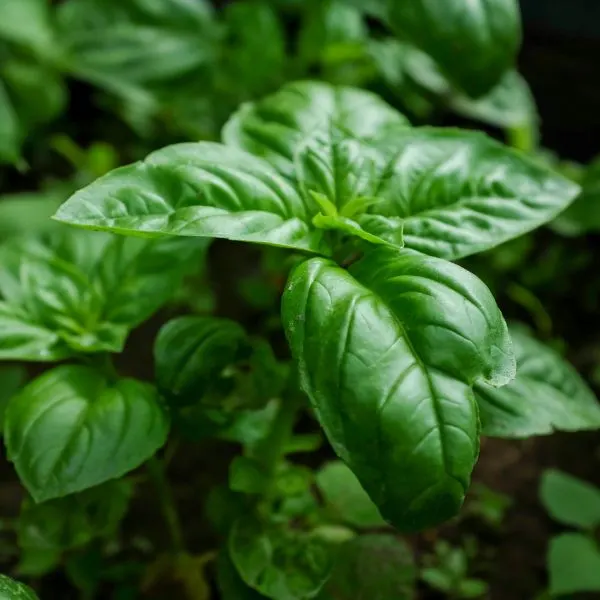
- Botanical name: Ocimum basilicum
- Sun Requirements: Full sun
- Soil Type: Fertile, moist, and well-drained soil
Basil makes a fine companion for grapes for a few very good reasons. First off, it can give your grapes a little bit of shade on a hot day, without overdoing it. Basil also repels a lot of pests, including whiteflies and aphids, and its scent in the air is going to help to hide the grape’s scent from animals that might want to come and nibble them. All in all, basil and grapes are a pretty good pair.
2. Oregano
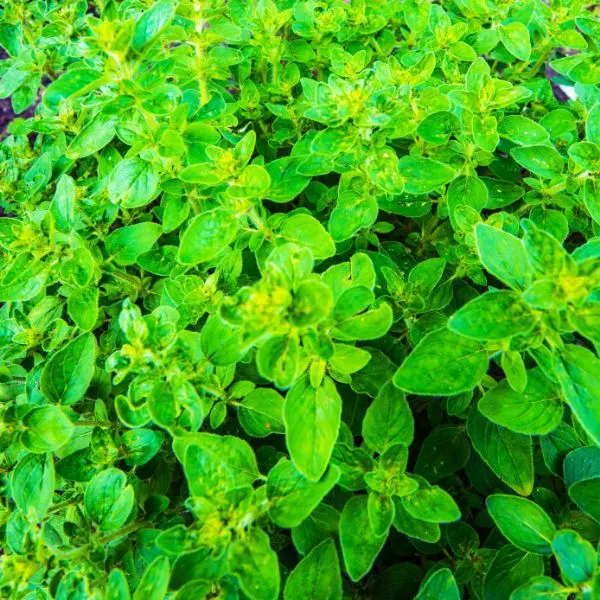
- Botanical name: Origanum vulgare
- Sun Requirements: Full
- Soil Type: Sandy and well-drained soil
Fresh oregano sure is nice to have in the kitchen, so if you’re going to be growing some anyway, why not pair them with your grapes? Like basil, oregano has a robust and unmistakable scent that helps to mask the scent of your grapes from hungry critters. It will also repel aphids and other pets and as a final bonus, oregano will add a little extra nitrogen to the soil that your grapes will take good advantage of.
4. Hyssop
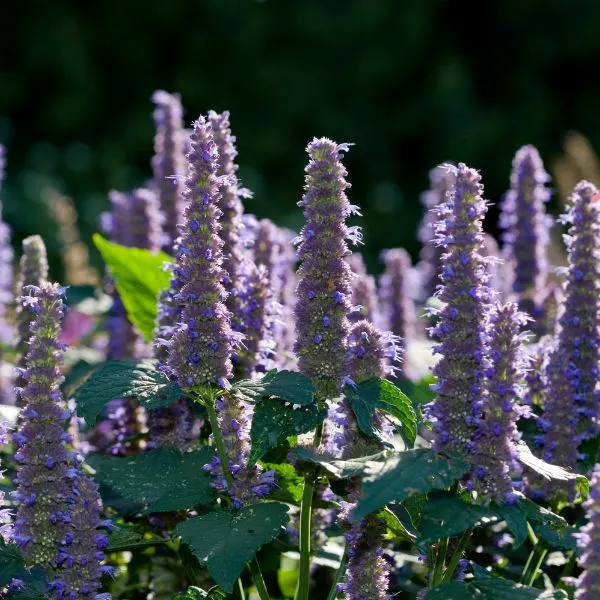
- Botanical name: Hyssopus officinalis
- Sun Requirements: Full sun
- Soil Type: Fertile, well-draining loam (will tolerate sandy)
Hyssop, a medicinal perennial favorite of many gardeners, just so happens to be an excellent companion for grapes. The scent of the plant will help to deter pests, but it will also attract pollinating bees for your garden. Hyssop is also said to actually improve both the yield and the flavor of grapes and while we can’t confirm this with science yet, we can say that this pairing is an old gardening tradition that you’ll see in grapevines around the world.
5. Mint

- Botanical name: Mentha
- Sun Requirements: Full sun to partial shade
- Soil Type: Fertile, well-drained soil
Mint is another good option for planting with your grapes, especially if you love that sharp, sweet, and oh-so-distinctive smell. While the mint scent is pleasant to us, a lot of pests simply can’t stand it, so it makes a lovely natural barrier that you can use for a little extra security against caterpillars, aphids, beetles, and more! Just keep a close eye on it or host it in a pot, as mint has a tendency to spread very quickly unchecked.
6. Rosemary
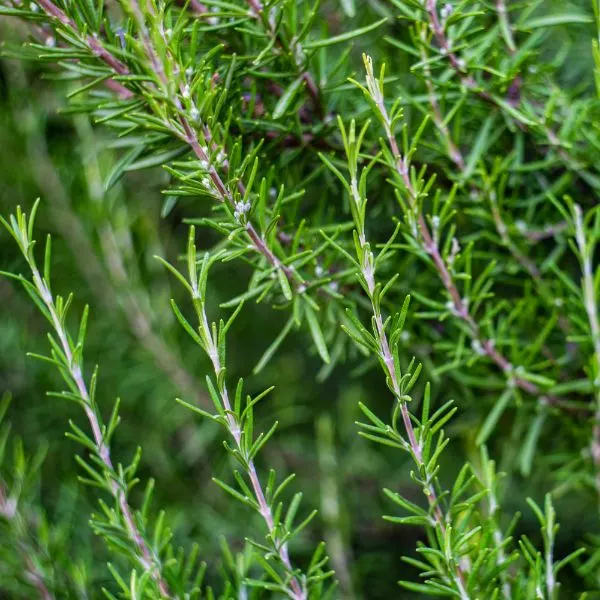
- Botanical name: Salvia rosmarinus
- Sun Requirements: Full sun
- Soil Type: Any well-draining soil, although clay or sandy loam is best
Aside from being delicious and making a fine natural preservative, Rosemary is also a great choice for planting close to your grapevine. It doesn’t need a lot to thrive – rosemary is a tough plant that will make due with just about any soil you have – and the scent of it will repel pests, while its nectar will attract bees and ladybugs. Not a bad deal at all, we think, so be sure to consider giving this pairing a try!
7. Lavender
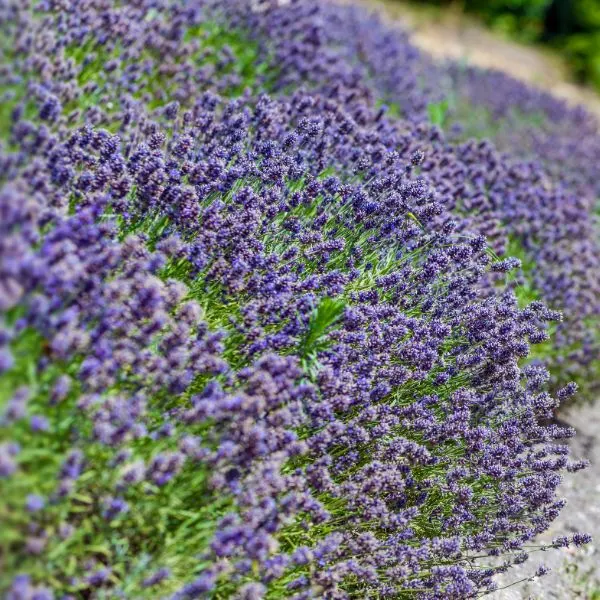
- Botanical name: Lavandula
- Sun Requirements: Full sun or partial shade (if summer is very hot in your area)
- Soil Type: Fertile (low to moderate) soil, well drained, neutral to very slightly alkaline
If you’ve ever been downwind of real lavender plants, it’s a scent that you won’t soon forget, but it brings a lot more to the table than that. With lavender, mites and aphids tend to keep their distance, and it has natural antifungal properties that you can even distill into oils to help other plants.
Aside from this, it also attracts pollinators and finally, it creates a network of roots that help to keep soil erosion at bay, and ensure that the soil is good and nutritious for your grapevine.
8. Chamomile

- Botanical name: Matricaria chamomilla
- Sun Requirements: Full sun of partial shade
- Soil Type: Fertile, well-drained loam or sandy loam is best
Homemade chamomile tea beats the stuff you get in stores by miles and as it’s a good companion for grapes, why not try pairing the two? The chamomile will help your grapevine with its antifungal properties, as well as the scent which will drive away pests such as spider mites and aphids, but which will also attract useful pollinators to your garden.
Healthy Veggies and Delicious fruits
9. Beans
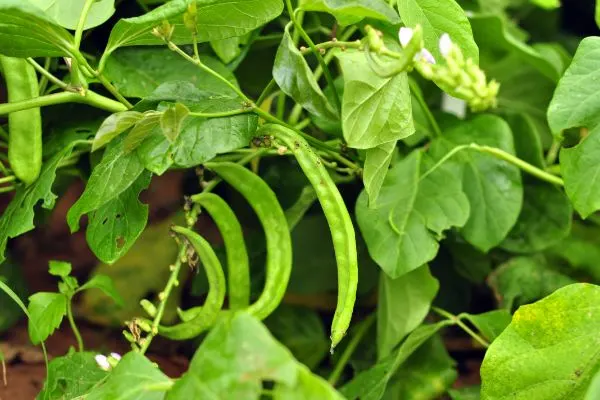
- Botanical name: Phaseolus vulgaris L.
- Sun Requirements: Full sun
- Soil Type: Clay or silt loam, well-drained, slightly acidic to neutral
Beans and grapes can get along like gangbusters in your garden and those beans really come with some useful perks. They’ll attract predatory insects, for one thing, who will munch on some of the less desirable ones, and since they grow up tall, they’ll give your grapes a little shade from time to time.
Beans also spike the nitrogen levels in soil and will improve its overall drainage. Reducing the chance that you’ll accidentally overwater your grapes. Not too shabby as far as companion plants go!
10. Blackberries
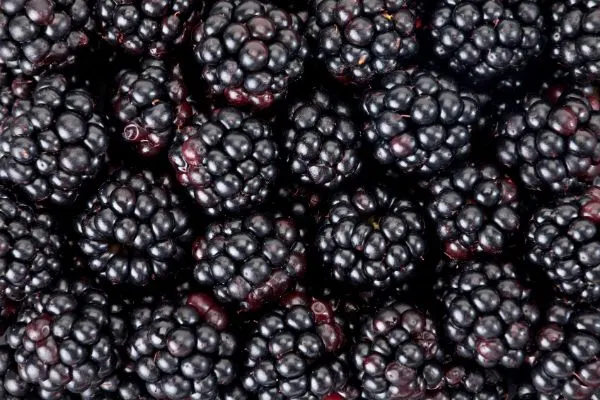
- Botanical name: Rubus subg. Rubus
- Sun Requirements: Full sun
- Soil Type: Well-drained, acidic, sandy or loamy
Blackberries and grapes have similar growth requirements, but if you space them a bit then they can make great neighbors in your garden. The reason to plant them close has to do with your grapevine’s vulnerability to leaf-hopper bugs. Blackberries tend to attract wasps and some types which will go after leafhopper eggs and take care of them for you before they can become a problem with your grapevine.
It’s a natural defense that’s a little more on the aggressive side, courtesy of mother nature.
11. Chives

- Botanical name: Allium schoenoprasum
- Sun Requirements: Full sun
- Soil Type: Fertile, moist, well-drained soil
Chives make good chums with your grapevine and as they don’t need a lot of resources, these two won’t be competing. When you add in that this yummy allium plant keeps away aphids and other pests, then it’s a great pairing for keeping your grapes safe and for providing fresh chives when you need them!
12. Garlic
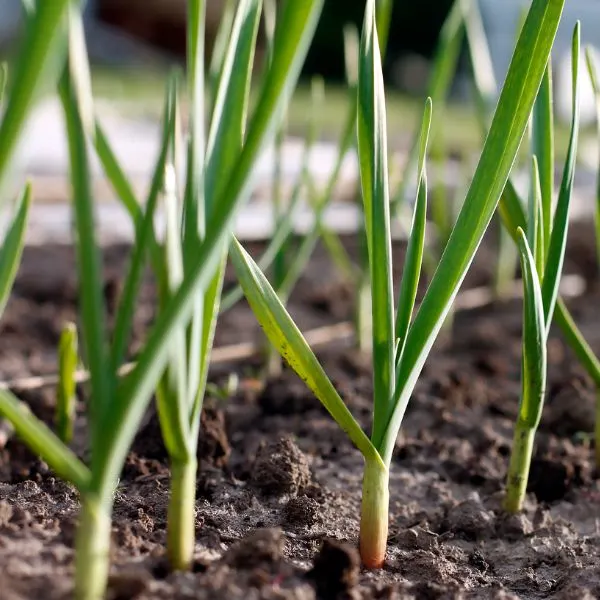
- Botanical name: Allium sativum
- Sun Requirements: Full sun
- Soil Type: Loamy and well-drained, with lots of organic matter
Speaking of alliums, everyone’s favorite allium – Garlic – can be grown with your grapes for a little extra insurance against pests. Garlic makes an excellent repellant for many insects and hungry animals with its signature smell, but you’ll want to keep a little distance from your grapes for best results.
While being in close proximity will give the benefits that you are looking for, if you plant them too close together then they might fight a little over resources. So, give them a little space or even better, just pot your garlic and you can keep it close to keep those pesky bugs away.
13. Asparagus
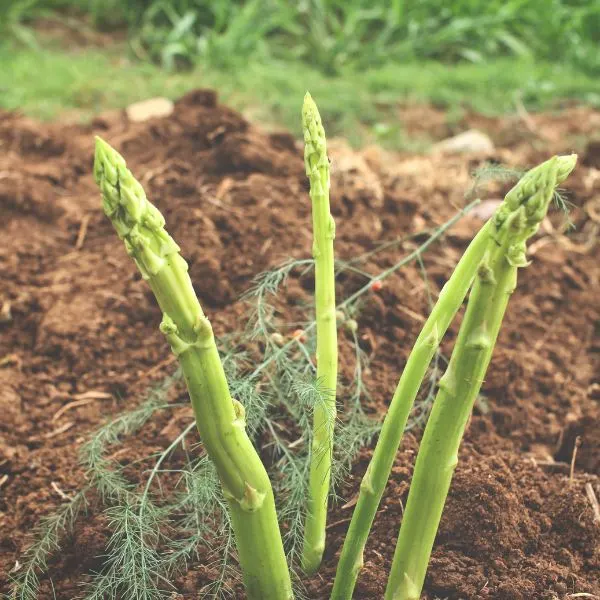
- Botanical name: Asparagus officinalis
- Sun Requirements: Full sun or dappled shade
- Soil Type: Sandy, well-drained soil
They might look like an odd couple, but as companions asparagus and grapes make good friends, indeed. Asparagus isn’t very picky about where it is planted and can thrive on very little, so it’s not going to challenge your grapes for important resources. While it’s not as handsome as your grapevines will be, at the root level it’s going to be performing the very useful function of helping to keep soil erosion at bay.
If that wasn’t enough, as a final perk asparagus secretes a compound that helps to prevent fungus in both itself and any close neighbors. Say what you will about asparagus, but this tasty veggie really pulls its own weight as a companion plant!
14. Mulberry tree

- Botanical name: Morus
- Sun Requirements: Full sun
- Soil Type: Fertile, well-drained, and moisture retentive soil
Mulberry trees of any kind make good buddies for your grapevine for a number of reasons. For one thing, their roots do a great job at aerating the soil and helping it to drain more efficiently. On a hot summer’s day, it also gives your grapes a little respite from the heat with a nice bit of shade.
Birds are attracted to mulberry trees, so this will add a nice living defense for your grapevine, and when the leaves fall from the tree, you’ll even get some free and natural mulch. It’s a pretty good pairing, we’d have to say, and hey… free mulberries!
15. Strawberries

- Botanical name: Fragaria × ananassa
- Sun Requirements: Full sun
- Soil Type: Well-drained, sandy loam
Fancy some fresh strawberries? While they won’t repel any pests, strawberries can help your grapes by providing a little nice ground cover. This will help for keeping the soil moist, which comes in pretty handy when it’s hot outside. It’s not a wide assortment of benefits like most of the other pairings on our list, but it’s still a good one and you get strawberries in the bargain!
Ornamental additions
16. Geraniums
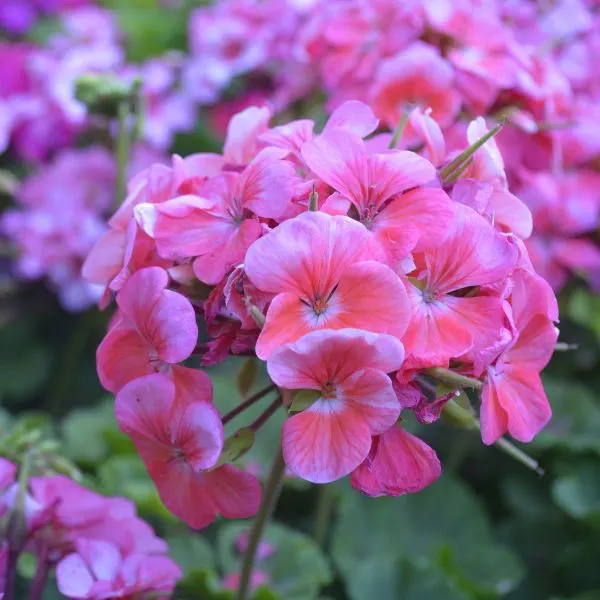
- Botanical name: Pelargonium
- Sun Requirements: Full sun
- Soil Type: Fertile, well-drained soil
Geraniums will help to keep those pesky leafhoppers away from your grapes, and they’ll also look amazing while they’re doing it. Not only do geraniums come in many flower colors, but even the leaves may be golden, red, multicolored, or even patterned. They’ll definitely bring the color and style, and the leafhopper utility is not too shabby, either!
17. Nasturtiums
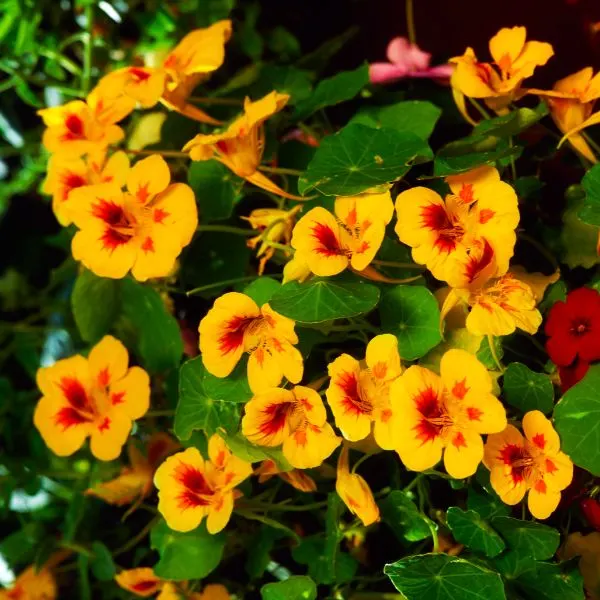
- Botanical name: Tropaeolum majus
- Sun Requirements: Full sun
- Soil Type: Fertile, well-drained soil
Nasturtiums can help to keep away various beetles, aphids, flies, and other pests from your grapes, while bringing a lovely contrast of green leaves and red, cream, orange, or yellow flowers that are sure to delight you come springtime. Those pretty leaves, flowers, and every other part of nasturtium are also completely edible, just in case you’d like to try a little something new in your salad.
18. Marigolds
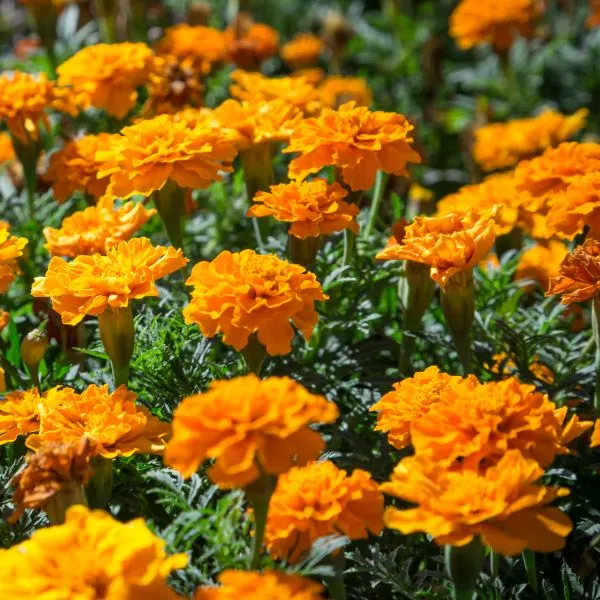
- Botanical name: Tagetes
- Sun Requirements: Full sun
- Soil Type: Loamy, well-drained
Marigolds bring beauty wherever you plant them, but next to your grapes they also work a little magic on the local insects. Pests such as aphids and whiteflies can’t stand the scent of it, but that same scent will lure in lacewings and ladybugs who can gobble up the other insects that decide to stick around. It’s a pairing that will protect your grapes and also ramp up the aesthetics of the area where you are hosting your grapevines.
19. Sunflowers
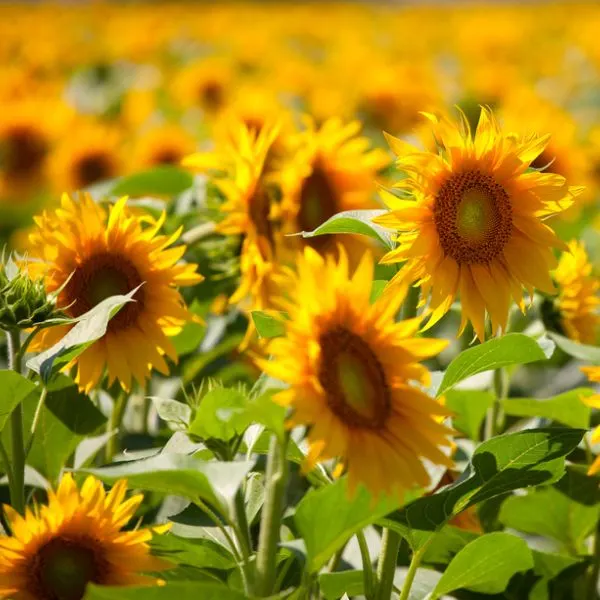
- Botanical name: Helianthus
- Sun Requirements: Full sun
- Soil Type: Well-drained, sandy loam soil
Sunflowers are a beautiful choice as an ornamental that comes with the occasional snack if you want to dry the seeds. Paired with grapes, these two plants will actually get along very well for a few different reasons. First off, Sunflowers are tall, but thin and sway a bit in the wind, so they aren’t going to compete for sunlight and will even give a bit of a barrier against that aforementioned wind.
They can also help to support grapevines and at the root level, Sunflowers actively improve the soil’s drainage and aerate it quite nicely. As such, this is an aesthetic pairing that comes with a whole lot of utility and let’s face it – that’s really the best kind!
Bad companion plants for Grapes
We’ve shared a few of the good companions, so naturally it’s time to warn you about some companion choices that your grapes really won’t be pleased about. We’ll tell you a little about the ‘why’ of it in the sections below so that you’ll know why these plants are better off at a distance.
Let’s take a look!
1. Cabbage
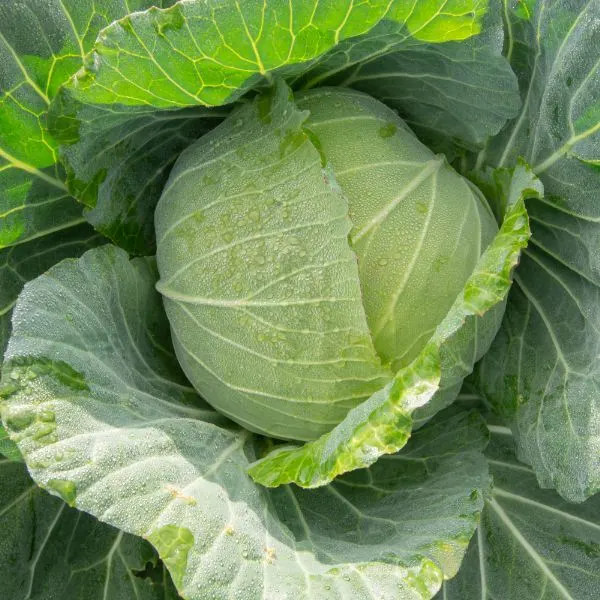
Cabbage and grapes just don’t get along in your garden. Starting off, cabbage is best planted when it’s cool, but grapes need to be planted in the spring or early summer, so these two will be put into a situation where they are fighting over space. It gets worse, though, as cabbage and grapes need a lot of the same nutrients, and cabbage has a habit of hogging them first. It’s better for both plants if you simply keep them away from each other in their own little garden niches.
2. Radishes

Radishes, like cabbage, should definitely not be planted too close to your grapes, as they are going to start fighting over resources if you do. If you are absolutely dead-set on planting them together, you could probably pot them, but otherwise it’s really best to keep them far away from your delicious grapes.
3. Cucumbers
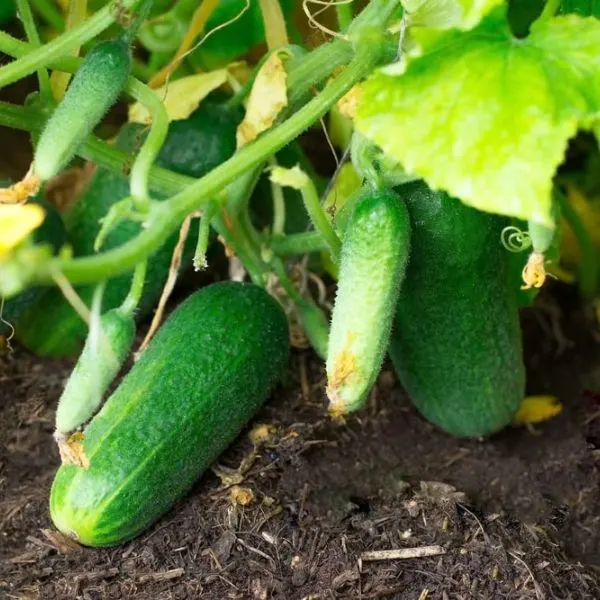
While you could certainly trellis them nearby and have cucumbers and grapes get along, in too close of quarters it is not a good idea. The problem that you will have is that these are both vining plants, and so they are going to be sending those vines out and competing for the most sunlight and for much the same resources in the soil. As such, while you could put them nearby with their own stand or trellis, just be very careful that they don’t get too close or you’ll have a little ‘vine war’ on your hands.
4. Black Walnut trees
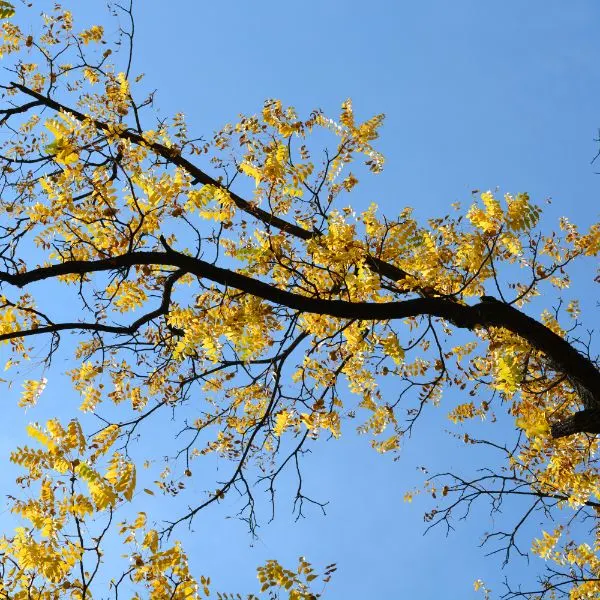
Black Walnut trees should Not be planted anywhere near your grapes. For one thing, the roots are very resource-hungry and so your grapes will have a hard time getting the nutrients that they need. Morce concerning, however, is a substance secreted by black walnut trees called ‘juglone’, which is actually toxic for your grapevine.
As such, if you want walnuts, just be sure to plant them somewhere else – they really won’t get along with your grapes at ALL.
FAQs
It’s time to start wrapping things up and before we do, we’ve got a few frequently asked questions that we get on the subject of companion plants for your grapes to help give you a little additional info before we make our exit. We hope that you find this information useful and that said, here are those questions and their answers.
What else can you not plant next to grapes?

Aside from the flowers and the herbs that we’ve shared with you today, you’re going to find that a lot of herbs and flowers simply will not play well with your grapes. Since grapevines can be a little on the sensitive side, we recommend that you research any potential pairings carefully to avoid pitfalls, especially with flowers and herbs.
Other than those, any vining plants are not typically going to be recommended, as they’re going to compete for resources and space. Beyond these, though, just use your best judgment and a quick check on Google definitely wouldn’t hurt!
Are Roses really used as companion plants to detect diseases before they get the grapevine?

You may have heard about this strategy, but some French vineyards would traditionally plant roses at the end of grapevine rows. The reason for this is that the roses will attract a lot of pests and keep them away from the vines, but roses also have a tendency to get mildew or diseases such as black rot much faster than it would develop on your grapevines.
This serves as an early and sweet-smelling natural warning system to help protect the vineyard’s crops.
What are some other good companion plants for grapes?

Grapes will actually get along with quite a lot of plants. Examples include Lemongrass, which helps hide your grapes from pests and gives them shade, and clovers, which help to improve the soil quality for them, but the list is actually quite big so it’s hard to share a lot in the space we have allotted for today.
A quick set might include Tarragon, Thyme, Oak and Elm trees, mustard, horseradish, and apple trees (along with a lot of other types of fruit trees). Give it a quick Google and you’ll see for yourself. When it comes to companion planting with grapes, you’ve definitely got a LOT of options!
…and that’s a wrap!
In today’s article we’ve shared some good companion plants that you can grow with your grapes, as well as some plants that you will be better off keeping in their own little corner of your garden. Fruit trees, like Mulberry trees, come highly recommended and with herbs and ornamentals, you’ll want to do a little homework if you pick something that’s not on today’s list.
It’s odd, really… grapevines play very well with quite a lot of plants, but with a handful of others the pairing can really be quite dangerous for the vines. So, just be sure to do your homework or just take advantage of what we’ve shared today to get you started with companion planting for your grapes.
Once you see all of the benefits that a little planting strategy provides then you’ll be taking your garden to the next level, and come harvest time, the rewards can be very sweet indeed! Thanks so much for reading, folks, and we hope to see you again soon!
More companion plants
